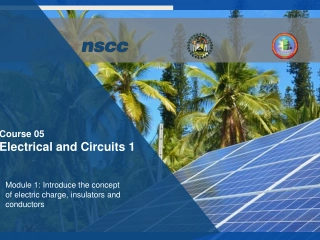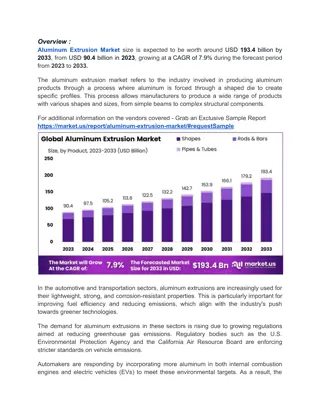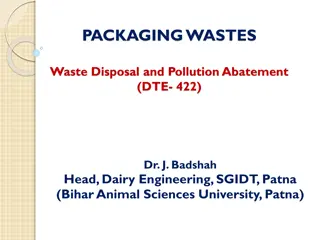Electrical and Circuits 1
Electric charge, insulators, conductors, and electrical flow through materials. Understand static electricity and examples of static charge uses. Discover the concept of insulators with analogies and examples.
0 views • 26 slides
Understanding the EDIPO2 Test Facility at Swiss Plasma Center
The Swiss Plasma Center at cole Polytechnique Fdrale de Lausanne (EPFL) houses the Superconductivity Group responsible for testing superconductor samples for projects like ITER, DTT, and DEMO. The facility comprises two test facilities, SULTAN & EDIPO, and engages in activities like developing condu
4 views • 40 slides
ECE 305 Electromagnetic Theory
Explore the fundamental concepts of electric fields in material space, covering topics such as free space, conductors, insulators, semiconductors, current conduction, and charge density. Delve into the properties of materials, convection vs. conduction current, and the role of superconductors in ele
1 views • 25 slides
Understanding the Manufacturing Process of aluminum casting parts
Aluminum casting is a widely used manufacturing process in various industries, including automotive, aerospace, construction, and electronics. It involves pouring molten aluminum into a mold to produce a desired shape or part.
2 views • 5 slides
Exploring Electricity Concepts: From Atoms to Static Electricity
This content delves into the basics of electricity, covering topics such as atoms, charges, static electricity, simple circuits, and more. Learn about the difference between naturally occurring and human-harnessed electricity, explore the concept of charges in objects, and discover how static electr
5 views • 14 slides
Understanding Electricity and Circuits: Basics, Components, and Applications
This educational course covers topics such as circuit symbols, calculating and measuring electrical quantities, identifying circuits, and understanding the relevance of electricity in engineering. It explains essential circuit components like energy sources, conductors, insulators, loads, control de
12 views • 30 slides
Understanding Chemical Bonds and Ionic Compounds
Ionic bonds are formed when atoms transfer electrons to achieve stable electron configurations, resulting in the creation of ions with positive or negative charges. Metals are good conductors due to their ability to easily lose electrons. The charges of ions depend on the number of valence electrons
0 views • 49 slides
Understanding Transmission Media and Twisted Pair Cables in Communication
Transmission media plays a crucial role in communication by transmitting data through electromagnetic signals. It is classified as guided media (using cables) and unguided media (waves through air, water, or vacuum). Twisted pair cables are a common type of guided media, consisting of insulated cond
5 views • 32 slides
Electrical Conductor Ampacity Calculation Scenarios
Various scenarios are presented involving the calculation of allowable ampacity for different types of electrical conductors connected to circuit breakers with temperature limitations. The calculations consider factors like conductor material, size, temperature ratings, and ambient conditions to det
0 views • 140 slides
Understanding Insulators: Properties, Materials, and Testing
An insulator is a crucial device used to support and insulate electric conductors or equipment from ground or other conductors. This article covers the definition, desirable properties, materials used, ratings, and testing methods of insulators, including flashover tests, sample tests, and routine t
1 views • 33 slides
Understanding Thermal Conductors and Insulators in Energy Transfer
Today's lesson focuses on energy transfer, specifically on conductors and insulators. Learn about the characteristics of thermal conductors and insulators, how they affect the flow of thermal energy, and their real-life applications. By the end of this lesson, you will be able to distinguish between
0 views • 13 slides
Understanding Redox Reactions in Chemistry
Salts can be prepared through redox reactions involving metals and acids. This interactive lesson covers oxidation numbers, identifying oxidized and reduced elements, and explaining electron transfer in redox reactions. Examples include reactions of aluminum with sulfuric acid and magnesium with cop
2 views • 12 slides
Chemfos 700/710 Vxx Zinc Phosphate with Versa Bond Rinse Conditioner
Chemfos 700/710 Vxx Zinc Phosphate with Versa Bond Rinse Conditioner is a zinc phosphate-based surface conditioning material used in the water rinse before the zinc phosphate stage. It acts as a nucleating agent for superior crystal refinement, offering benefits like sludge reduction, compatibility
0 views • 4 slides
Understanding Electrochemistry in Engineering Chemistry
Electrochemistry in engineering chemistry explores the interactions between electrical and chemical energy, involving the conversion of energy forms. It discusses electrical conductors, insulators, metallic conductors, good conductors, semiconductors, and electrolytic conductors. The concept of elec
4 views • 56 slides
Advantages and Requirements of Underground Cables
Underground cables offer advantages like better protection from damage, fewer faults, and improved appearance. However, they come with higher installation costs and insulation challenges at high voltages. Requirements include using high-conductivity stranded copper or aluminum conductors, proper ins
0 views • 22 slides
Understanding Electrical Conductors and Insulators
Electrical conductors like metals allow the flow of charge, while insulators like wood and plastic impede the flow. Copper, silver, and aluminum are examples of good conductors, with high conductivity. Insulators have high resistivity, preventing the easy flow of electric current. Learn about the pr
3 views • 5 slides
Understanding Chemical Effects of Electric Current
The chemical effects of electric current involve reactions in conducting solutions through which an electric current passes. This phenomenon leads to various effects like electroplating, formation of gas bubbles, deposition of metals, and changes in solution color. Conductors play a vital role in al
5 views • 17 slides
Aluminum Extrusion Market Thrives Despite Challenges: Innovations and Opportunit
Aluminum Extrusions Market; By Product(Shapes, Rods & Bars, Pipes & Tubes), By Type(2000 Series Aluminum, 3000 Series Aluminum, 5000 Series Aluminum, 6000 Series Aluminum, 7000 Series Aluminum), By Application(Building & Construction, Automotive & Tr
0 views • 4 slides
Understanding Electric Charges and Conductors in Physics
Explore the fundamentals of electrostatics, electric charges, conductors, and insulators in physics. Learn about the Law of Electric Charges, types of charge, conductors vs. insulators, and methods of charging objects through friction, conduction, and induction. Dive into the world of atoms, electro
1 views • 14 slides
Understanding the Hall Effect in Conductors
The Hall Effect in conductors is described in detail, showcasing how a magnetic field affects the conductivity tensor, breaking symmetry and leading to unique properties. The discussion covers the separation of the conductivity tensor, the impact of magnetic fields on conductivity components, and th
1 views • 16 slides
Insights on Conductors and Gauss Law in Physics
Explore electric fields in and near conductors, understand Gauss Law, and delve into the behavior of electrons inside a conductor. Discover why there can be no electric field inside a conductor in electrostatics and learn about the distribution of charges on a conductor's surface. Consider scenarios
4 views • 19 slides
Understanding Thermal Energy Transfer Methods
Explore the three primary ways thermal energy is transferred - conduction, convection, and radiation. Dive into the characteristics of good conductors, such as metals, and how they facilitate heat transfer. Learn about the role of insulators in controlling thermal energy flow and discover the best h
1 views • 24 slides
Operational Improvements for Aluminum Smelter in Trondheim
The aluminum smelter in Trondheim is facing challenges with high CO2 emissions and operational inefficiencies. To avoid hefty penalties and improve practices, recommendations include reducing amperage, enforcing operating procedures, meeting specifications for alumina and coke purchasing, renovating
0 views • 11 slides
Understanding Electricity: Conductors, Insulators, and Current
Electricity is essential for modern life, with conductors allowing electron flow and insulators preventing it. Learn about the basics of atoms, electrons, and how electricity works through conductors and insulators. Discover the role of current and how electrons behave in different materials, drawin
0 views • 19 slides
Methods of Solving Electrostatics Problems in Conductor Systems
Understanding problem-solving methods in electrostatics, including the use of images and fictitious point charges to analyze interactions between conductors and charges. Exploring scenarios with semi-infinite and finite conductors, grounded and insulated spheres, and the concept of equipotential sur
0 views • 36 slides
Top Non-Ferrous Metal Products in Demand for Indian Industries (1)
1.Aluminum: The Versatile Metal\n\nAluminum is one of the most popular non-ferrous metals in India, and for good reason. It is lightweight, strong, corrosion-resistant, and highly conductive. These properties make it suitable for a wide range of industries including automotive, construction, electri
1 views • 2 slides
Step-by-Step Guide to Making Aluminum Foil Packages
Pre-cut heavier aluminum foil into a square, fold it to create a small-lipped package, fold the sides carefully, and ensure it fits a filter before sealing and storing in liquid nitrogen or freezer for preservation. Follow these steps for efficient packaging!
0 views • 7 slides
Understanding Electrical Conductors and Insulators in Grade 6 Natural Sciences and Technology
Explore the topic of electrical conductors and insulators in Grade 6 Natural Sciences and Technology, learning about wiring a three-pin plug, the colors of the live, neutral, and earth wires, and the steps involved in wiring a South African three-pin plug. Gain insight into the roles of each wire an
0 views • 14 slides
Friction Stir Welding of Aluminum Plate: COMSOL Simulation
Manufacturers use friction stir welding to join aluminum plates efficiently. This modern method generates frictional heat to soften the aluminum, allowing dissimilar materials to be welded together. The model in COMSOL considers heat transfer and boundary conditions to simulate the welding process,
0 views • 8 slides
Optimizing Aluminum Smelting Operation Parameters for Energy Efficiency
The current efficiency of an aluminum smelting operation is at 94% with excess AlF3 superheat, operating at low energy consumption. However, to comply with a power cap, the manager wants to reduce the voltage by 0.2V. This voltage decrease leads to a heat balance problem, necessitating actions such
0 views • 6 slides
Powder Can Types: Vanadium and Aluminum with Various Flanges and Lids
Explore the different types of powder cans available, including Vanadium cans with aluminum flanges and lids, as well as aluminum cans with aluminum flanges, all designed for specific temperature and pressure measurements. The cans vary in size, lid diameter, screws used, and materials like steel, c
0 views • 4 slides
Metal Smelting and Electrorefining Techniques Explained
Smelting is a process involving the dissolution of pure alumina in a molten mixture of cryolite and fluorspar to extract metals like aluminum. Electrolysis is used to separate the metals where oxygen is liberated at the anode and the metal is deposited at the cathode. This process is illustrated wit
0 views • 29 slides
Exploring Cheaper Coke Options for Aluminum Production Cost Reduction
The discussion focuses on the potential cost-saving strategies in aluminum production by considering two coke options: existing coke (coke E) and a blend of 2/3 coke E and 1/3 coke A. The blend offers cost savings but may lead to quality loss and increased Net Carbon Consumption. Additionally, impro
0 views • 5 slides
Understanding the Design and Elements of Armature in DC Machines
The design of armature in DC machines involves various factors such as armature windings, number of conductors, coils, slots, voltage drop, peripheral speed, and more. Armature winding arrangements play a crucial role in producing electromotive forces through relative motion in a magnetic field. Com
0 views • 27 slides
Impact of Packaging Wastes on Environment and Recycling Efforts
Packaging wastes, including glass, aluminum, steel, and paper containers, contribute significantly to solid waste generation. In 2015, millions of tons of packaging products were discarded, with varying recycling rates and disposal methods. Glass containers accounted for a substantial portion of was
0 views • 8 slides
Understanding Electricity: Charges, Conductors, Insulators, and Storms
Explore the fundamentals of electricity, including electric charges, neutral charges, static electricity, conductors, insulators, lightning storms, and the phenomenon of lightning strikes. Learn about the laws of conservation of charge, electric fields, and the properties of conductive and insulatin
0 views • 23 slides
Understanding Electric Charge and Interactions Between Objects
Matter is composed of neutrons, protons, and electrons with different charges. Being charged means having an excess or shortage of charge. Grounding, insulators, conductors, and methods of charging play important roles in how objects get charged. By contacting charged objects with objects that can g
0 views • 33 slides
Types of Conductors in Transmission Lines
Aluminum conductors, such as AAC, AAAC, ACSR, and ACAR, are commonly used in transmission lines due to their high conductivity, tensile strength, light weight, and resistance to corrosion. AAC is known for its good conductivity but limited strength, while AAAC offers better mechanical strength and c
0 views • 17 slides
Physical and Chemical Properties of Metals and Non-metals
Metals exhibit physical properties like lustrous appearance, ductility, malleability, and sound production. They are also good conductors of heat and electricity. Non-metals, on the other hand, are brittle, non-sonorous, and poor conductors of heat and electricity. The chemical properties include re
0 views • 13 slides
Understanding Electricity: From Static Shocks to Conductors
Delve into the world of electricity, demystifying phenomena like static shocks, sticky socks in dryers, and the science behind lightning and auroras. Explore the properties of charge in atoms, electric forces, Coulomb's Law, conductors vs. non-conductors, and more. Gain insights into volts, amps, oh
0 views • 22 slides







































